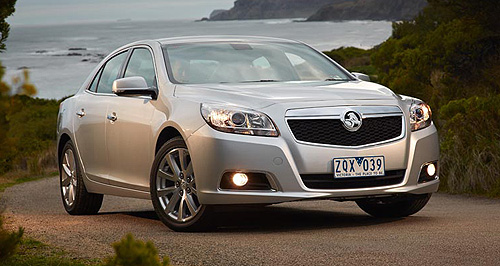News - Holden - MalibuMalibu takes diesel Commodore’s mantleLean burn: Holden’s diesel-engined Malibu has better fuel efficiency than a base-model Commodore despite weighing more. Commodore large car was never ready for a diesel engine, Holden says17 Jun 2013 By BARRY PARK HOLDEN’S lightweight new VF Commodore would have needed major re-engineering to fit a fuel-sipping diesel engine under the bonnet, the Australian car-maker has admitted. Instead, the heavier and slightly smaller imported Malibu mid-sizer, launched in Australia last week, will fill the diesel void in the Commodore line-up, potentially stripping more fleet sales off the struggling locally built large car. The Commodore-sized Malibu – there is only a handspan in length between them – will use an economical 117kW/350Nm 2.0-litre four-cylinder turbo-diesel engine under its bonnet that officially uses only 6.4L/100km on the combined cycle and emits 170g/km of carbon dioxide. By comparison, the most fuel-efficient Commodore, the 185kW/290Nm 3.0-litre V6 Evoke, uses 8.3L/100km and emits 198g/km of CO2 – despite the 1622kg Commodore weighing almost 40 kilograms less than the diesel Malibu after a radical weight-loss program brought with the VF upgrade. “We’ve been considering diesel since the Commodore was introduced in 2006,” Holden program engineering manager Andrew Holmes said at the recent launch of the VF Commodore. “One of the restraints of diesel (in the Commodore) is that it has had to meet a strict set of criteria including a cost-benefit analysis, and the result of that has always been that the cost of doing diesel is always too big.” One of the problems, Mr Holmes said, was that the Commodore’s Zeta chassis was designed as a “gas-only chassis” that would need major re-engineering to work with a diesel powertrain. “There were problems with NVH (noise, vibration and harshness) from the powertrain and transmission, and the vibrations it created would have needed a major, major chassis and frame upgrade because the diesel engine’s transfer of NVH into the body was unacceptable,” he said. He said trials of a diesel powerplant had found the noise and vibration of the engine were at the wrong frequency for the Commodore, and would make it unsuitable. “You also have to consider the life cost of diesel, which is also higher than petrol because servicing costs are much higher,” he said. “There’s more up-front cost with the purchase price, too.” Holden set out to chase valuable fleet sales with the new Commodore, with weight and performance stripped from the base-model Evoke to help it save fuel and slip below fleet buyers’ 200 grams per kilometre cut-off on CO2 emissions. The 2.4-litre petrol-powered version of the Korean-made Malibu officially uses 8.0L/100km, with its CO2 emissions of 192g/km slipping in under the fleet cut-off, and weighs almost 40kg less than the entry-level Commodore. The cleanest Commodore is the LPG-fuelled Evoke, which emits only 185g/km of carbon dioxide despite its relatively high 11.5L/100km fuel use.  Read more |
Click to shareHolden articlesResearch Holden Motor industry news |
















Facebook Twitter Instagram